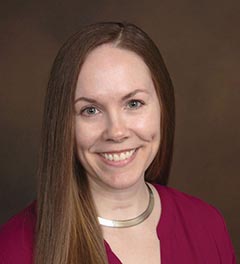Current Research Related to Speaking Valve Use with the Pediatric Population
Jessica Nourse, SLP.D, CCC-SLP
Current research documents that use of a Passy Muir® Valve during eating and drinking decreases laryngeal penetration and aspiration in adults (Muz et al., 1989; Stachler et al., 1996; Dettelback et al., 1995; Suiter, McCullough, & Powell, 2003; Elpern et al., 2000). Improvements in oropharyngeal functioning for patients with tracheostomies can result in improved outcomes related to morbidity and accrued healthcare related expenses. The investigators of this study conducted research on the effect of the Passy Muir Valve on swallowing in pediatric patients with tracheostomies. Twelve patients were identified for inclusion in the study, all of whom could tolerate a speaking valve for the purpose of phonation and for whom modified barium swallow studies were indicated. Each participant wore two valves during the study, a Passy Muir Valve and a sham valve, and was trialed with two consistencies of liquids and solids. Two speech-language pathologists, who were unaware of the valve status, rated the modified barium swallow study results with the Rosenbeck 8 Point Penetration and Aspiration Scale (PAS). Findings of the study were inconclusive regarding the effect of the Passy Muir Valve on penetration and aspiration, however, five patients out of the 12 participants demonstrated improvements in PAS with the Passy Muir Valve in place. A significant difference was noted with the presence of the Passy Muir Valve in the decrease of pyriform sinus residue across all patients. Overall, patients who underwent tracheotomy due to respiratory failure or prematurity demonstrated more improvement in their pharyngeal functioning with use of the Passy Muir Valve as compared to patients with upper airway obstructions.
Previous research has demonstrated that vocal exploration and social interaction is essential for normal speech and language development, which can be limited with the presence of a tracheostomy tube (Kalson & Stein, 1985; Simon, Fowler, & Handler, 1983). Supporting attainment of developmental outcomes for infants and children with tracheostomy tubes, while acknowledging the medical fragility and comorbidities that often accompany the need for treatment within the neonatal intensive care unit remains an area of concern. In this article, the authors document a protocol for use of Passy Muir® Valve within a neonatal intensive care unit (NICU). The authors identified a need for a systematic, team-based approach to assessing speaking valve readiness and tolerance for both nonmechanically ventilated and mechanically ventilated neonatal patients. Their protocol was formalized in 2010 and is used by the multidisciplinary team of neonatologists, ENT nurse practitioners, speechlanguage pathologists, and respiratory therapists. The protocol implementation resulted in an increased number of referrals for speaking valve trials with neonatal patients, as well as an improvement in quality of patient care. The authors identified two possible future uses of their protocol: (1) measurement of caregiver/infant bonding pre- and post-speaking valve use; and (2) measurements of weaning from mechanical ventilation with use of the Passy Muir Valve with neonatal patients.
Speaking valves can be an integral part of advancing language growth in pediatric patients with tracheostomies (Lewis & Carron, 2003). Respiratory therapy and speech-language pathology goals are often intertwined when working with patients with tracheostomies, making interdisciplinary coordination of care essential (Torres & Sirbegovic, 2004). The authors of this article document the interdisciplinary protocol for Passy Muir Valve use within their hospital, including measures of patient candidacy and exclusion criteria. A critical aspect of their protocol was the emphasis on the interdisciplinary team developing individualized treatment plans to improve consistency of speaking valve wear, thereby increasing length of tolerance. Through interdisciplinary collaboration and standardization of care, pediatric patients received the optimal benefit of speaking valve use within a systematic and safe framework.
Previous research studies consistently and effectively demonstrated the negative effect of tracheostomy placement on the expressive language skills of infants and children (Karlson & Stein, 1985; Hill & Singer, 1990; Singer et al., 1991; Ross, 1982; Simon, Fowler, & Handler, 1983; Kaman & Watson, 1991). Limited research has been available regarding expressive language development through use of speaking valves targeting restoration of voicing in infants and children with tracheostomies.
Investigators of this study identified that pediatric patients with tracheostomies often spend prolonged periods within healthcare settings (hospitals, rehabilitation centers), during which a collaborative, team-based approach for speaking valve use would be beneficial. The researchers conducted a retrospective evaluation of inpatient pediatric tracheostomy cases to determine the percent of patients able to tolerate the Passy Muir Valve, whether phonation was achieved with the Valve and which secondary benefits (improved secretion management, restoration of coughing ability, and improvements in feeding and swallowing) were observed. Twelve cases were reviewed, with 10 children able to tolerate Valve placement during initial evaluation and three subsequent trials. All of the 10 children were able to achieve phonation by the completion of the trials, and significant improvement in vocal quality was noted for the six children who demonstrated hydrophonic vocal quality during the initial Valve placement. A productive cough was noted for all children, and one of the two children who were noted to have secretion management concerns, demonstrated significant improvement with decreased oral pooling of secretions.
This article is from the Fall 2017 Pediatric Issue of Aerodigestive Health. Click here to view Current Research Related to Speaking Valve Use with the Pediatric Population.
References:
Hofman, L., Bolton, J., and Ferry, S. (2008). Passy Muir Valve use in a children’s hospital: An interdisciplinary approach. SIG 3 Perspectives on Voice and Voice Disorders, 18, 76-86. doi: 10.1044/vvd18.2.76
Hull, E.M., Humas, H.M., Crowley, R.A., and Kharasch, V.S. (2005). Tracheostomy speaking valves for children: Tolerance and clinical benefits. Pediatric Rehabilitation, 8(3), 214-219. doi: 10.10801/13638490400021503
Ongkasuwan, J., Turk, C.L., Rappazzo, C.A., Lavergne, K.A., Smith, E.O., and Friedman, E.M. (2014). The effect of a speaking valve on laryngeal aspiration and penetration in children with tracheostomies. Laryngoscope, 124, 1469-1474.
Stevens, M., Finch, J., Justice, L., and Geiger, E. (2011). Use of the Passy Muir Valve in the neonatal intensive care unit. Neonatal Intensive Care, 24(7), 22-23.











